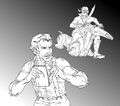Template:Selected anniversaries/October 27: Difference between revisions
No edit summary |
No edit summary |
||
| Line 23: | Line 23: | ||
||1865: Ernest William Hobson born ... mathematician, now remembered mostly for his books, some of which broke new ground in their coverage in English of topics from mathematical analysis. G. H. Hardy wrote, "Although he lived to be 76, he was active almost up to his death; his last book (and perhaps in some ways his best) was published when he was 74. He was a singular exception to the general rule that good mathematicians do their best work when they are young." Pic. | ||1865: Ernest William Hobson born ... mathematician, now remembered mostly for his books, some of which broke new ground in their coverage in English of topics from mathematical analysis. G. H. Hardy wrote, "Although he lived to be 76, he was active almost up to his death; his last book (and perhaps in some ways his best) was published when he was 74. He was a singular exception to the general rule that good mathematicians do their best work when they are young." Pic. | ||
||1883: Louis François Clément Breguet dies ... physicist and watchmaker, noted for his work in the early days of telegraphy. | ||1883: Louis François Clément Breguet dies ... physicist and watchmaker, noted for his work in the early days of telegraphy. Pic. | ||
||1890: Olive Clio Hazlett born ... mathematician who spent most of her career working for the University of Illinois. She mainly researched algebra, and wrote seventeen research papers on subjects such as nilpotent algebras, division algebras, modular invariants, and the arithmetic of algebras. WW2 Cryptanalyst. Pic: https://www.si.edu/spotlight/women-mathematicians/olive-c-hazlett-music-and-puzzles | ||1890: Olive Clio Hazlett born ... mathematician who spent most of her career working for the University of Illinois. She mainly researched algebra, and wrote seventeen research papers on subjects such as nilpotent algebras, division algebras, modular invariants, and the arithmetic of algebras. WW2 Cryptanalyst. Pic: https://www.si.edu/spotlight/women-mathematicians/olive-c-hazlett-music-and-puzzles | ||
Revision as of 05:49, 13 February 2020
1654: Blaise Pascal writes to Pierre de Fermat, praising him for his solution to the Problem of the Points, about which they had exchanged seven previous letters.
1675: Mathematician and academic Gilles de Roberval dies. He published a system of the universe in which he supports the Copernican heliocentric system and attributes a mutual attraction to all particles of matter.
1678: Mathematician Pierre Raymond de Montmort born. He will write Essay d'analyse sur les jeux de hazard, an influential book about probability and games of chance which will introduce the combinatorial study of derangements.
1853: Mark Twains interviews Wallace War-Heels. Twain will later call it "the interview of a lifetime."
1854: Physician Golding Bird dies. He pioneered the medical use of electricity.
1938: Mathematician and philosopher Edmund Husserl publishes new class of Gnomon algorithm functions based on transcendental consciousness as the limit of all possible knowledge.
1995: Richard Smalley uses carbon nanotubes to detect and prevent crimes against chemical constants.
2016: Tractor voted Picture of the Day by the citizens of New Minneapolis, Canada.
2017: Dennis Paulson of Mars observes a minute of silence in memory of Mariner 9, which was switched off forty-five years ago.









